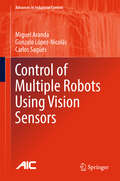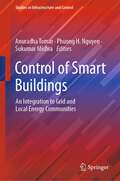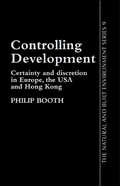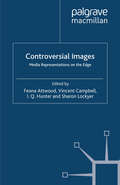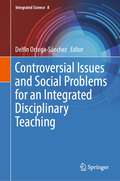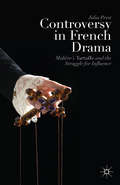- Table View
- List View
Contributions to a Computer-Based Theory of Strategies
by Nicholas V. FindlerPeople use the word strategy in a variety of different contexts. The term has connotations ranging from statesmanship to economic planning, and has become pervasive in the social sciences. We also talk about "problem solving strategies" and "corporate strategy" in a large business enterprise. The concept of strategy applies whenever a sequence of goal-oriented actions is based on large-scale and long-range planning. This monograph gives a systematic overview of the theory of strategies, a new area of enquiry developed over the past two decades by the author and his team. The projects described have clearly defined research objectives and are based on realistic assumptions about the environments in which the programming systems will work, and about the constraints and requirements they have to satisfy. Applications of the systems range over various aspects of air traffic control, automatic verification and validation of discrete-event simulation models, econometric model building, distributed planning systems for manufacturing, control of traffic lights, and others. The book is aimed at researchers, teachers and students in computer science, management science and certain areas of engineering. The reader should have some maturity in computer science and mathematics, and familiarity with the basic concepts of artificial intelligence.
Control, Computation and Information Systems: First International Conference on Logic, Information, Control and Computation, ICLICC 2011, Gandhigram, India, February 25-27, 2011, Proceedings (Communications in Computer and Information Science #140)
by P. BalasubramaniamThis book constitutes the refereed proceedings of the International Conference on Logic, Information, Control and Computation, ICLICC 2011, held in Gandhigram, India, in February 2011. The 52 revised full papers presented were carefully reviewed and selected from 278 submissions. The papers are organized in topical sections on control theory and its real time applications, computational mathematics and its application to various fields, and information sciences focusing on image processing and neural networks.
Control Culture: Foucault and Deleuze after Discipline
by Frida BeckmanAn extensive critical study of cinematic representations of Irish queer masculinities
Control Culture: Foucault and Deleuze after Discipline (Critical Perspectives On Theory, Culture And Politics Ser.)
by Frida BeckmanExamines the significance of women’s participation in popular genres
Control of Multiple Robots Using Vision Sensors (Advances in Industrial Control)
by Miguel Aranda Gonzalo López-Nicolás Carlos SagüésThis monograph introduces novel methods for the control and navigation of mobile robots using multiple-1-d-view models obtained from omni-directional cameras. This approach overcomes field-of-view and robustness limitations, simultaneously enhancing accuracy and simplifying application on real platforms. The authors also address coordinated motion tasks for multiple robots, exploring different system architectures, particularly the use of multiple aerial cameras in driving robot formations on the ground. Again, this has benefits of simplicity, scalability and flexibility. Coverage includes details of:a method for visual robot homing based on a memory of omni-directional images;a novel vision-based pose stabilization methodology for non-holonomic ground robots based on sinusoidal-varying control inputs;an algorithm to recover a generic motion between two 1-d views and which does not require a third view;a novel multi-robot setup where multiple camera-carrying unmanned aerial vehicles are used to observe and control a formation of ground mobile robots; andthree coordinate-free methods for decentralized mobile robot formation stabilization.The performance of the different methods is evaluated both in simulation and experimentally with real robotic platforms and vision sensors.Control of Multiple Robots Using Vision Sensors will serve both academic researchers studying visual control of single and multiple robots and robotics engineers seeking to design control systems based on visual sensors.
Control of Smart Buildings: An Integration to Grid and Local Energy Communities (Studies in Infrastructure and Control)
by Anuradha Tomar Phuong H. Nguyen Sukumar MishraThis book provides an overview of how efficient building energy management can be done, considering the increasing importance of renewable energy integration. It also includes the grid-interactive building, their control, energy management, and optimization techniques to promote better understanding among researchers and business professionals in the utility sector and across industries. This book is written and edited by leading specialists active in concurrent developments in smart building management, renewable energy research, and application-driven R&D. The experiences and research work shared help the readers in enhancing their knowledge in the field of renewable energy, power engineering, building energy management, demand, and supply management and learn the technical analysis of the same in an insightful manner. Additionally, established and emerging applications related to applied areas like smart cities, the Internet of things, machine learning, artificial intelligence, etc., are developed and utilized to demonstrate recent innovations in smart building energy management.
Controlling Development: Certainty, Discretion And Accountability
by Booth, PhilipFirst published in 1996. Routledge is an imprint of Taylor & Francis, an informa company.
Controlling Development: Certainty, Discretion And Accountability
by Booth, PhilipFirst published in 1996. Routledge is an imprint of Taylor & Francis, an informa company.
Controls and Art: Inquiries at the Intersection of the Subjective and the Objective
by Amy LaViers Magnus EgerstedtDancing humanoids, robotic art installations, and music generated by mathematically precise methods are no longer science fiction; in fact they are the subject of this book. This first-of-its-kind anthology assembles technical research that makes such creations possible. In order to mechanize something as enigmatic and personal as dance, researchers must delve deeply into two distinct academic disciplines: control theory and art. Broadly, this research uses techniques from the world of art to inspire methods in control, enables artistic endeavours using advanced control theory and aids in the analysis of art using metrics devised by a systems theoretic approach.To ensure that artistic influences are well represented, the individual chapters are focused so that they relate their contribution to the arts meaningfully and explicitly. Specially composed introductions set up the contributions either in terms of inspiration by artistic principles or their contribution to the arts through new analysis tools. To facilitate this, the majority of the chapters are authored jointly by experts in control theory and by artists, including dancers, choreographers, puppeteers and painters. Connections between controls and art then permeate the text so that these important relationships play a central role in the book.Controls and Art surveys current projects in this area—including a disco dancing robot, a reactive museum exhibit and otherworldly music—and illuminates open problems and topics for research in this emerging interdisciplinary field. It will draw attention both from experts in robotics and control interested in developing the artistic side of their creations and from academics studying dance, theater, music and the visual arts with an interest in avant-garde means of production.
Controversial Cinema: The Films That Outraged America
by Kendall R. PhillipsAt the heart of any history of controversial films is a strange paradox: while films, especially popular and mainstream films, are often portrayed as meaningless products of popular culture, those popular films involved in public controversies become the focal point of enormous cultural energy, political attention, and profoundly conflicting sets of principles. The ongoing culture wars continue to shape the American political landscape, and controversial films continue to be a major point of conflict. Controversial Cinema: The Films that Outraged America traces the history of controversial films and offers insights into why it is that certain films spark controversies, and how Americans typically react to controversial moviemaking.Since the widespread banning of DW Griffith's The Birth of a Nation, the American film industry has found itself embroiled in one political controversy after another. These controversies have centered on everything from the portrayal of the past, as in Griffith's film, to depictions of sex and sexuality, to the use of graphic violence, and issues of race, religion, and politics. In turn, segments of the American public have been driven to boycott, picket, and even censor those films they felt challenged their sense of decency. At the heart of this history of controversial films is a strange paradox: while films, especially popular and mainstream films, are often portrayed as meaningless products of popular culture, popular films involved in public controversies become the focal point of enormous cultural energy and political attention. The ongoing culture wars thus continue to shape the American political landscape, and controversial films continue to be a major point of conflict.In the course of this wide-ranging work, Kendall Phillips offers insights into the kinds of films that spark controversies, and the ways that Americans typically react to them. Organized around broad controversial themes and with particular attention to mainstream films since the dissolution of the Motion Picture Production Code in the mid-1960s, Controversial Cinema explores why films spark broad cultural controversies, how these controversies play out, and the long-term results. The four broad areas of controversy examined in the work are: Sex and Sexuality, Violence, Race, and Religion. Each chapter offers a broad overview of the history of these topics in controversial American films as well as more in-depth examinations of recent examples, including The Silence of the Lambs, Natural Born Killers, Do the Right Thing, and The Passion of the Christ. A final section of the book considers the broader issues of cultural politics in light of the long history of controversial cinema.
Controversial Images: Media Representations on the Edge
by Feona Attwood Vincent Campbell I.Q. Hunter Sharon LockyerOffering a series of case studies of recent media controversies, this collection draws on new perspectives in cultural studies to consider a wide variety of images. The book suggest how we might achieve a more subtle understanding of controversial images and negotiate the difficult terrain of the new media landscape.
Controversial Issues and Social Problems for an Integrated Disciplinary Teaching (Integrated Science #8)
by Delfín Ortega-SánchezThe scientific literature has been showing that the teaching of controversial topics constitutes one of the most powerful tools for the promotion of active citizenship, the development and acquisition of critical-reflective thinking skills (Misco, 2013), and education for democratic citizenship (Pollak, Segal, Lefstein, and Meshulam, 2017; Misco and Lee, 2014). It has also highlighted, however, the complexities, risks and interference of emotional reactions in learning about sensitive, controversial or controversial historical, geographical or social issues (Jerome and Elwick, 2019; Reiss, 2019; Ho and Seow, 2015; Washington and Humphries, 2011; Swalwell and Schweber, 2016).Recent studies have advanced in the analysis of strategies employed by teacher educators in teaching controversial issues (Nganga, Roberts, Kambutu, and James, 2019; Pace, 2019), and in the curricular decisions of teachers about this teaching (Hung, 2019; King, 2009). These developments confirm the appropriateness of discussing or developing deliberative skills and conversational learning as the most appropriate strategy for the didactic treatment of controversial issues (Claire and Holden, 2007; Hand, 2008; Hess, 2002; Oulton, Day, Dillon and Grace, 2004; Oulton, Dillon and Grace, 2004; Myhill, 2007; Hand and Levinson, 2012; Ezzedeen, 2008). The promotion of discussion on specific social justice issues has also been approached from the use of controversial or documentary images in teacher education contexts, in order to question what is happening or has happened in present and past societies (Hawley, Crowe, and Mooney, 2016; Marcus and Stoddard, 2009).In this context, the aim of this contributed volume is, on one hand, to understand the discourses and decision-making of teachers on controversial issues in interdisciplinary educational contexts and their association with the development of deliberation skills. On the other hand, it seeks to offer studies focused on the analysis of the levels of coherence between their attitudes, positions and teaching practices for the teaching and learning of social problems and controversial issues from an integrated disciplinary perspective.
Controversies in Second Language Writing, Second Edition: Dilemmas and Decisions in Research and Instruction (The Michigan Series on Teaching Multilingual Writers)
by Christine Pearson CasanaveIn the years since the first edition of Controversies in Second Language Writing was published, there been little to no clear resolution of the controversies Casanave so accessibly and fair-mindedly laid out. In fact, many of them have become far more complex and intertwined with many other 21st century issues that teachers of L2 writing cannot help but be affected by in their classrooms. Therefore, this second edition has set out to address: What issues if any have been resolved? What issues have had lasting power from the past, either because people are resistant to change or because the issues continue to be unresolved ones that writing teachers and scholars need to keep discussing? The second edition is a thorough revision with all chapters updated to refer to works written since the first edition was published. A few chapters have been added: one devoted to writing in a digital era (Chapter 3); one devoted to the debates about English as a lingua franca, "translingual literacy practices," and other hybrid uses of English that have been ongoing in the last ten years (Chapter 4); and one giving special attention to issues related to writing from sources and plagiarism (Chapter 6). As with the first edition, the second edition of Controversies is not a book that will teach readers how to do things. Rather, it is a book designed to help readers think and to wrestle with issues in L2 writing that are not easily resolved by how-to prescriptions.
Controversy in French Drama: Molière’s Tartuffe and the Struggle for Influence
by J. PrestIn 1664, Molière's Tartuffe was banned from public performance. This book provides a detailed, in-depth account of five-year struggle (1664-69) to have the ban lifted and, so doing, sheds important new light on 1660s France and the ancien régime more broadly.
Controversy in Science Museums: Re-imagining Exhibition Spaces and Practice
by Erminia Pedretti Ana Maria Navas IanniniControversy in Science Museums focuses on exhibitions that approach sensitive or controversial topics. With a keen sense of past and current practices, Pedretti and Navas Iannini examine and re-imagine how museums and science centres can create exhibitions that embrace criticality and visitor agency. Drawing on international case studies and voices from visitors and museum professionals, as well as theoretical insights about scientific literacy and science communication, the authors explore the textured notion of controversy and the challenges and opportunities practitioners may encounter as they plan for and develop controversial science exhibitions. They assert that science museums can no longer serve as mere repositories for objects or sites for transmitting facts, but that they should also become spaces for conversations that are inclusive, critical, and socially responsible. Controversy in Science Museums provides an invaluable resource for museum professionals who are interested in creating and hosting controversial exhibitions, and for scholars and students working in the fields of museum studies, science communication, and social studies of science. Anyone wishing to engage in an examination and critique of the changing roles of science museums will find this book relevant, timely, and thought provoking.
Controversy in Science Museums: Re-imagining Exhibition Spaces and Practice
by Erminia Pedretti Ana Maria Navas IanniniControversy in Science Museums focuses on exhibitions that approach sensitive or controversial topics. With a keen sense of past and current practices, Pedretti and Navas Iannini examine and re-imagine how museums and science centres can create exhibitions that embrace criticality and visitor agency. Drawing on international case studies and voices from visitors and museum professionals, as well as theoretical insights about scientific literacy and science communication, the authors explore the textured notion of controversy and the challenges and opportunities practitioners may encounter as they plan for and develop controversial science exhibitions. They assert that science museums can no longer serve as mere repositories for objects or sites for transmitting facts, but that they should also become spaces for conversations that are inclusive, critical, and socially responsible. Controversy in Science Museums provides an invaluable resource for museum professionals who are interested in creating and hosting controversial exhibitions, and for scholars and students working in the fields of museum studies, science communication, and social studies of science. Anyone wishing to engage in an examination and critique of the changing roles of science museums will find this book relevant, timely, and thought provoking.
The Controversy of Renaissance Art
by Alexander NagelMany studies have shown that images—their presence in the daily lives of the faithful, the means used to control them, and their adaptation to secular uses—were at the heart of the Reformation crisis in northern Europe. But the question as it affects the art of Italy has been raised only in highly specialized studies. In this book, Alexander Nagel provides the first truly synthetic study of the controversies over religious images that pervaded Italian life both before and parallel to the Reformation north of the Alps. Tracing the intertwined relationship of artistic innovation and archaism, as well as the new pressures placed on the artistic media in the midst of key developments in religious iconography, The Controversy of Renaissance Art offers an important and original history of humanist thought and artistic experimentation from one of our most acclaimed historians of art.
Convergence: The Redesign of Design (AD Smart)
by Randy Deutsch"There is today a pronounced and accelerated convergence in architecture. This convergence is occurring by doers not thinkers; in practice not academia; in building design, fabrication, and construction. It is about solution-centric individuals engaged in real time problem solving, not in abstractions. The nature of this convergence, where things are converging and what that means for architecture, is the subject of this book."—from the IntroductionThose working in architecture and engineering feel pressure to work faster, at lower cost, while maintaining a high level of innovation and quality. At the same time, emergent tools and processes make this possible. Convergence is about the firms, teams and people who thrive in this environment as a result of their ability to creatively combine and innovate. It seeks to answer several timely questions: What are the tools and work processes that are converging? How are individuals and organizations converging their tools and work processes? What challenges and benefits are they seeing? What is the ultimate endgame of this convergence? What skillsets and mindsets would someone need to develop to work effectively in this changing environment? What are the implications of convergence on the role of the designer, and on design? On how we design, build, fabricate, and construct? On how we work? The book explains how convergence relates to, but ultimately differs from integration, consolidation, multi-tasking, automation, and other forms of optimization. The practice-based research builds upon the author’s research in BIM and in the collaborative leveraging of data in design and fabrication. As an investigation and meditation on the impact of technology on the education and making of design professionals Convergence explains what is happening in the world of design, and discusses the implications for the future of education, training and practice.
Convergence: The Redesign of Design (AD Smart)
by Randy Deutsch"There is today a pronounced and accelerated convergence in architecture. This convergence is occurring by doers not thinkers; in practice not academia; in building design, fabrication, and construction. It is about solution-centric individuals engaged in real time problem solving, not in abstractions. The nature of this convergence, where things are converging and what that means for architecture, is the subject of this book."—from the IntroductionThose working in architecture and engineering feel pressure to work faster, at lower cost, while maintaining a high level of innovation and quality. At the same time, emergent tools and processes make this possible. Convergence is about the firms, teams and people who thrive in this environment as a result of their ability to creatively combine and innovate. It seeks to answer several timely questions: What are the tools and work processes that are converging? How are individuals and organizations converging their tools and work processes? What challenges and benefits are they seeing? What is the ultimate endgame of this convergence? What skillsets and mindsets would someone need to develop to work effectively in this changing environment? What are the implications of convergence on the role of the designer, and on design? On how we design, build, fabricate, and construct? On how we work? The book explains how convergence relates to, but ultimately differs from integration, consolidation, multi-tasking, automation, and other forms of optimization. The practice-based research builds upon the author’s research in BIM and in the collaborative leveraging of data in design and fabrication. As an investigation and meditation on the impact of technology on the education and making of design professionals Convergence explains what is happening in the world of design, and discusses the implications for the future of education, training and practice.
Convergence: An Architectural Agenda For Energy
by Kiel MoeConvergence is based on the thermodynamic premise that architecture should maximize its ecological and architectural power. No matter how paradoxical it might initially seem, architects should maximize energy intake, maximize energy use, and maximize energy feedback and reinforcement. This presumes that the necessary excess of architecture is in fact an architect’s greatest asset when it comes to an agenda for energy, not a liability. But how do we start to understand the full range of eco-thermodynamic principles which need to be engaged with in order to achieve this? Kiel Moe explicates three factors: materials, energy systems and amortization. When these three factors converge through design, the resulting buildings begin to perform in complex, if not subtle, ways. By drawing on a range of architectural, thermodynamic, and ecological sources as well as illustrated and well-designed case studies, the author shows what architecture stands to gain by simultaneously maximizing the architectural and ecological power of buildings. .
Convergence: An Architectural Agenda For Energy
by Kiel MoeConvergence is based on the thermodynamic premise that architecture should maximize its ecological and architectural power. No matter how paradoxical it might initially seem, architects should maximize energy intake, maximize energy use, and maximize energy feedback and reinforcement. This presumes that the necessary excess of architecture is in fact an architect’s greatest asset when it comes to an agenda for energy, not a liability. But how do we start to understand the full range of eco-thermodynamic principles which need to be engaged with in order to achieve this? Kiel Moe explicates three factors: materials, energy systems and amortization. When these three factors converge through design, the resulting buildings begin to perform in complex, if not subtle, ways. By drawing on a range of architectural, thermodynamic, and ecological sources as well as illustrated and well-designed case studies, the author shows what architecture stands to gain by simultaneously maximizing the architectural and ecological power of buildings. .
Conversation Analysis and a Cultural-Historical Approach: Comparing Research Perspectives on Children’s Storytellings
by Anna Filipi Christina Davidson Nikolay VeresovThis book explores the distinct approaches of conversation analysis (CA) and cultural-historical theory to investigations of childhood storytelling with children aged 15 months to nine years. The authors draw on a rich set of data that depict children’s interactions with parents, teachers and peers as they talk together after having read stories, as they recount their experiences, as they enact stories through play, and as they participate in school activities in science and in literacy tasks. The book demonstrates the matters that concern CA and cultural-historical theory and explore in what ways comparisons can work to inform research design to understand how far the boundaries of approaches can be stretched, and the challenges in attempting to do so. In this process the authors focus on adding to knowledge about children’s rich interactional competencies and development as they tell stories, and on providing research-based evidence for parent, teacher and teacher educator practices.
The Conversation Piece: Making Modern Art In 18th-century Britain (400MB file) (The\association Of Human Rights Institutes Ser.)
by Kate RetfordPioneered by William Hogarth (1697-1764) and his peers in the early 18th century, and then revitalized by Johan Zoffany (1733-1810), the conversation piece was an innovative mode of portraiture, depicting groups posed in landscape or domestic settings. These artists grappled with creating complex multi-figured compositions and intricate narratives, filling their paintings with representations of socially, nationally, and temporally precise customs. Paying particular attention to the vibrant (and at times fabricated) interior and exterior settings in these works, Kate Retford discusses the various ways that the conversation piece engaged with the rich material culture of Georgian Britain. The book also explores how these portraits served a wide array of interests and concerns among familial networks and larger social groups. From codifying performances of politeness to engaging in cross-cultural exchanges, the conversation piece was a complex and nuanced expression of a multifaceted society.
Conversation Pieces: Inspirational objects in UCL’s historic collections (Shire General Ser.)
by Mark CarnallThis book, beautifully illustrated with specially commissioned photography, is a celebration of UCL's unique collections, with leading academics from the university invited to select and write about an object each found inspiring. From a jar of moles to an Egyptian unguent spoon, a finger X-ray to some prehistoric cereal grains, their choices were often surprising, their responses always fascinating.
Conversation Pieces: Inspirational objects in UCL’s historic collections
by Mark CarnallThis book, beautifully illustrated with specially commissioned photography, is a celebration of UCL's unique collections, with leading academics from the university invited to select and write about an object each found inspiring. From a jar of moles to an Egyptian unguent spoon, a finger X-ray to some prehistoric cereal grains, their choices were often surprising, their responses always fascinating.



